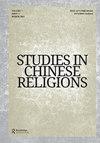唐宋禅宗思想史与日本禅宗——借用铃木的视角
IF 0.2
3区 哲学
0 ASIAN STUDIES
引用次数: 0
摘要
摘要在人人皆有佛性的共同前提下(福星佛性) 和初心本心), 关于如何将一个人作为佛的“原始自我”与一个人活着的、身体上的“真实自我”联系起来,有不同的思考方式。唐宋禅思想史上有四种类型。第一种是所谓的“北方”禅北宗禪, 它试图通过坐着冥想来克服“真实的自我”并恢复“原始的自我”。第二个是妈祖馬祖 (709-788)陈的世系,将二者视为一体。第三种禅是石头石頭 (710–790)世系,在批判妈祖世系的同时,把握二者为一、一者为二的关系。第四个是大辉的大慧 (1089-1163)陈干华看話禪 (观禅),回归第一种思维方式,增加了koan的新技巧公案 他们每个人都对中世纪的日本禅宗产生了强烈的影响,班基盤珪 (1622-1693)继承了第二种类型曹洞 继承第三种类型的学园白隱 (1686–1769)继承了第四种类型和Dōgen道元 (1200–1253)——为了超越第二种和第四种——对本书产生了独特的反思本證妙修 (“在根本实现中的巨大培育”)。本文章由计算机程序翻译,如有差异,请以英文原文为准。
The intellectual history of Chan Buddhism in the Tang and Song Dynasties and Japanese Zen: borrowing the perspective of D.T. Suzuki
ABSTRACT Under the common premise that everyone has buddha-nature (foxing 佛性) and original mind (benxin 本心), there are different ways of thinking about how to relate one’s ‘original self’ as a buddha to one’s living, physical ‘actual self’. There are four types of thought in the history of Tang-Song Chan Buddhism. The first is the so-called ‘Northern’ Chan 北宗禪, which seeks to overcome the ‘actual self’ and restore the ‘original self’ through seated meditation. The second is the Mazu 馬祖 (709–788) lineage of Chan, which treats the two as one. The third type of Chan is the Shitou 石頭 (710–790) lineage which, while criticizing the Mazu lineage, grasps the relationship between the two as one and one as two. The fourth is Dahui’s 大慧 (1089–1163) kanhua chan 看話禪 (Chan of Phrase-observing), which returns to the first type of thought and adds the new technique of koan 公案 to it. They each had a strong influence on Medieval Japanese Zen Buddhism, with Bankei 盤珪 (1622–1693) inheriting the second type, the Sōtō 曹洞 school inheriting the third type, Hakuin 白隱 (1686–1769) inheriting the fourth type, and Dōgen 道元 (1200–1253)—in order to transcend both the second and the fourth types—producing a unique reflection on the honshō myōshu 本證妙修 (‘Wondrous cultivation in fundamental realization’).
求助全文
通过发布文献求助,成功后即可免费获取论文全文。
去求助
来源期刊

Studies in Chinese Religions
Arts and Humanities-Religious Studies
CiteScore
0.20
自引率
0.00%
发文量
10
 求助内容:
求助内容: 应助结果提醒方式:
应助结果提醒方式:


